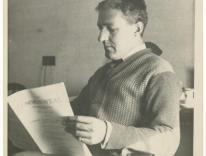This weekend, July 15-16, Venice, Italy will celebrate its annual feast of the Redentore (the Redeemer) with fireworks, gondola races, concerts, and a public procession over a pontoon bridge built from one section of the city to another. From 1575-1577, Venice suffered from a plague that killed somewhere between 25 and 30 percent of its population. In 1577, the city commissioned the great architect Andrea Palladio to design and build a church dedicated to the Redentore, who saved the Venice from destruction. Although Palladio designed the church, he died in 1580; it was completed in 1592 by Antonio da Ponte. The church has been staffed by Capuchins since its dedication. It is a breathtakingly beautiful structure. It is certainly Palladios masterpiece.The need for redemption surrounds Venice. Ecologically, the lagoon in which the city sits is under threat of rising seas. Demographically, the citys population is now under 60,000, and it continues to fall. And there is even the need to be saved from the glorious chaos of the streets: the 20 million tourists annually (of whom, it seems 1,999,800 dont speak Italian); the vaporettos (or waterbuses) filled to capacity; the gondoliers shouting Gondola, gondola, hello in the hopes of enticing customers; the merchants illegally selling handbags, sunglasses, or tchotchkas; the elderly Italians with sharp elbows who dont wait in line.
Adding to the chaos and wonder of the city this year is the Biennale, which brings contemporary art and artists from throughout the world together in one place. There are two main campuses for the Biennale: the Arsenal, where Venice once had its shipbuilding and naval facilities (and part of which is controlled by the Italian navy), and the Giardini, or Gardens, where a number of countries have pavilions to support their artists. There are also installations throughout the city.
The theme of this years Biennale is ILLUMInazioni, a clever play on both light and the international character of the exhibition. According to the exhibitions brochure, the title is both evocative and compelling. The references it contains are obvious (from the theme of light, to the poetry of Arthur Rimbaud, from the writings of Walter Benjamin to the Biennales very structure composed of national pavillions), but this title also wishes to emphasize one of arts intrinsic characteristics: it is a unique and illuminating experience. There is simply too much art to encounter. I dont think that you could do justice to all the works even if you had a month in the city. (And of course, that does not even count the Accademia Museum and the Guggenheim collection and all the churches!) During my visit here, Ive tried to experience as much of the art as possible, and three pieces caught my attention, two of them are in the Arsenale and one is in main pavillion in the Giardini.
In the Arsenale, two works stood out. James Turrells Ganzfield APANI is difficult to describe. After waiting in line for roughly forty-five minutes, I was allowed into the installation, but before I did, I had to put on little plastic booties. I then walked up about five or six steps and entered what can only be described as a white box, whose dimensions are approximately 2000 cm x 1120 cm x 660 cm. There is ambient florescent colored lighting at one end, and there is lighting on the inside of the entrance. While there, one loses all sense of time and perspective. The closest equivalent I could think of was Dantes Paradiso, when the pilgrim is drawn to the light as he reaches the Empyrean. For five minutes, heaven, redemption, seemed tantalizingly near.
You can get a taste of the installation here.
If Turrell helps us rethink space, Christian Marklays The Clock helps us rethink time. I looked at it for roughly 70 minutes. I know this because The Clock is a 24-hour movie that takes scenes from the history of cinema. Just about every scene has a clock in it, and the movie is synchronized to real time. Many, although not all, of the scenes talk about the nature of time. Watching the film was simultaneously constricting and liberating. It was almost as if becoming ever more focused on time brought brief moments of transcending it.
You can see about five minutes of the movie here.
The Giardini, as I mentioned, has national pavilions, and it also has one main pavilion, which exhibits art from artists around the world. In the center of that main pavilion, somewhat jarringly, are three paintings from the 16-century Venetian painter Jacopo Tintoretto. And the centerpiece of those three paintings is Tintorettos Last Supper, which normally is found above and to the right of the altar in San Giorgio Maggiore (another Palladian church). In situ, the painting is difficult to see, although its liturgical placement not only over the altar but across from Tintorettos painting of the Israelites being fed manna in the desert is perfect. But here, in the Biennale, one can see this masterpiece at eye level. It is the only last supper painting I know where Christ is actually feeding one of the disciples, the redeemer offering the food of redemption.
Now Ill admit that when I hear illuminations or light of the nations, I dont think of Rimbaud or Benjamin. But I did think of the following verse from Isaiah:
It is too little, he says, for you to be my servant,
To raise up the tribes of Jacob,
And restore the survivors of Israel.
I will make you a light to the nations,
That my salvation may reach to the ends of the earth. (Is. 49:6)
I dont think art can bring us that salvation, but I would like to think that there is a connection between the illuminations art brings and redemption, between ILLUMInazioni and lumen gentium.


